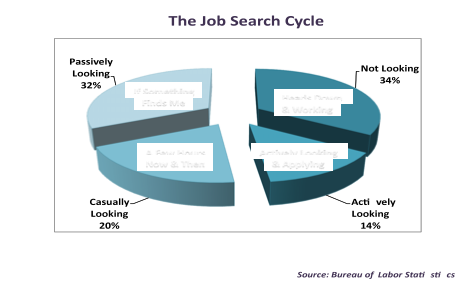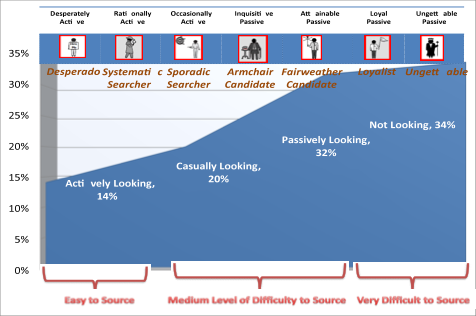This is the first of a series of three articles discussing Microsoft’s approach to building pipelines and talent communities. The articles are entitled:
- Being on the Cutting Edge Can Be Rewarding
- Being on the Cutting Edge Can Be Challenging
- Being on the Cutting Edge Can Be Painful
One year ago, I began a discussion of our work at Microsoft by suggesting that “Building a 21st century talent community requires using the right mix of recruiting art and science. “ I felt “we needed to dip back into the prehistoric art of developing relationship with prospects.” I noted that while a “21st century recruiting technology” optimized a “technology touch” it is the “human touch” that is so valued by the potential prospect pool. I concluded “the challenge with ‘human touch’ is that it doesn’t fit well into our transaction based recruiting model. “
 As we end the second year of this talent community pilot program, the tension between the “technology touch” and the “human touch” has become increasingly evident. In fact, I believe the third year of this pilot rollout should be coined “The Year of Guanxi.” ([guan-shee] the basic dynamic in personalized networks of influence in Chinese society. As I reflect on our work for past year, it is evident that we have reached our goal of creating a platform that exhibits a very thorough approach to “technology touch” by creating a job distribution network that reaches deeply into active and passive talent pools.
As we end the second year of this talent community pilot program, the tension between the “technology touch” and the “human touch” has become increasingly evident. In fact, I believe the third year of this pilot rollout should be coined “The Year of Guanxi.” ([guan-shee] the basic dynamic in personalized networks of influence in Chinese society. As I reflect on our work for past year, it is evident that we have reached our goal of creating a platform that exhibits a very thorough approach to “technology touch” by creating a job distribution network that reaches deeply into active and passive talent pools.
Venues|Platforms for Evangelism
From the beginning, we have shared the work on this talent community pilot effort with the recruiting industry as a method of inviting feedback and fostering sharing of best practices with similar projects that are ongoing in the recruiting industry. It has been quite a year of evangelizing our work. We have enjoyed positive feedback from our initial presentation at Sourcecon 2008 to Human Capital Institute webinars to CareerXroads and Corporate Sourcing Leadership Council; SMA Event, HR Executive Forum, and other related venues.
Another purpose of these articles is a preview of our presentation for the Fall 2009 ERE Event, where our talent community pilot will be discussed in the broader context of Web 2.0 Beyond the Social Recruiting Hype: Microsoft’s Approach to Building Talent Pipelines and Communities.
Accolades
The accolades for our pilot have been very re-enforcing and flattering. ERE acknowledged our work with a “Most Strategic Use of Technology Award ” and industry thought leaders like Dr. John Sullivan called our work “pioneering.”
Microsoft Goals
Internally, at Microsoft, two of our corporate staffing goals are sourcing|recruiting the best candidates in the world and enhancing the candidate experience at Microsoft. While external acknowledgement is very complementary, how we perform alongside Microsoft goals and commitments are all that matters. In this talent community pilot, we see an opportunity to fulfill those goals.
Web 2.0 Recruitment Marketing Platform
At a high level we are creating a Web 2.0 Recruitment Marketing platform for our jobs that will be distributed to search engines, social networking sites, blogs and other relevant sites. In this manner, we will reach deep into talent pools with a “technology touch.” We will enhance the candidate experience by direct outreaches to micro-segments of our target audience and by establishing talent communities that will enhance the “human touch.” It is at the intersection of art and science that success is realized.
The “technology touch” of the Web 2.0 Recruitment Marketing sits on the Jobs2Web platform. Not only do we employ their unique dynamic Search Engine Optimization (SEO) technology, but we take advantage of total power of this platform to connect jobs and social networking sites as well as a CRM-orchestrated targeted outreach. We not only reach the active job seeker, but we capture passive seekers who visit the site and sign up for our email alerts, RSS feeds or any of our talent communities which allows us to maintain contact and cultivate ambient relationships with these prospects until they are ready to go deep with an employment conversation with Microsoft.
And best of all, we can measure every aspect all the moving parts using Jobs2Web Recruiting Dashboard which gives us visibility to all activity and exact sources of all candidates that come to our talent community (without asking the prospects) which helps us to know what sources are providing the best quality and quantity of candidates in the highly fragmented Web 2.0 World.
How We Measure Success
For the active (and a percentage of passive) prospects, success is measured by our jobs “being seen” or “being found” in the keyword search results. The chief reason to “optimize” our jobs is because job seekers primarily use search engines to look for a job (as opposed to job boards). The highlight outlined below illustrates the Search Engine Optimization (SEO) of our jobs on Google (which enjoys 70% of the market for job searches). As the graph demonstrates-97% of our targeted recruiting keywords (i.e. Seattle Developer Jobs, Washington .Net Jobs, Washington Tech Jobs, etc.) show up in the first page of Google search results.


To reach our ultimate goal of sourcing|recruiting the best talent in the world, we must use this “technology touch” to reach into talent pools that can be described as causal, passive or non-looking job seekers. When you think about active vs. the more passive job seeker, we have to remember that only a small percentage of the job market is actively searching for a new job at any point in time. The graph below illustrates this point. This graph was created using 2006 Bureau of Labor Statistics (the last official year), so we could conclude that the active job seeker market must be greater today given the high unemployment rate. So let’s say it is 20% today. Even at that level, that means that 80% of the available talent is not actively looking for work.

If we view the Job Search Cycle from a slightly different angle, we are able to see a more discreet method of classifying active vs. passive job seeking. The Recruiting Roundtable suggests we add the filter of” difficultly to source” as we move from left (easiest to source) to right (the most difficult to source) on the graph below.

|
Source: Bureau of Labor Statistics | Source: Recruiting Roundtable |
The degree of difficulty to source adds a deeper dimension to our thinking. So rather than just active or passive, we think about “gettables” and the “ungettables.” Most recruiters have antidotes about convincing a person not seeking a job to take a look at their opportunities. So I think that it makes sense that we can convince someone to look at a job. In fact the Recruiting Roundtable recently published a study that 83% (I have no idea why it is not 100%) of active job seekers would consider other jobs, while 42% of passive job seekers will consider other jobs.

| Source: Bureau of Labor Statistics | Source: Recruiting Roundtable |
It is difficult to project how many people will respond to “technology touch” vs. the “human touch.” Research tells us that even passive prospects engage in active prospect behavior. To that extent, we are able to connect with the “gettables” that may be casually or passively looking, the reach of technology touch will be far greater than just optimizing our jobs for the active job seeker. The “gettables” that can be reached by our SEO activities are highlighted in red below. The overall reach of our technology touch is depicted in green. How we reach the prospects in the green shaded area will be discussed next month.

To achieve the Microsoft goal of sourcing|recruiting the best candidates in the world, we must reach deep into targeted talent pools. Using the technology touch of our Recruitment Marketing platform, we are able to reach out to a greater targeted audience. The first step in how we measure success is with search engine optimization of our jobs that will be viewed by gettable talent. At the same time, we need to remember our second goal of enhancing the prospect|candidate experience. Next month, we will look at our second step, which examines how our Recruitment Marketing Platform connects social media as well as targets micro-segments of the target talent audience.